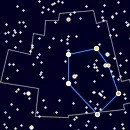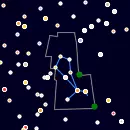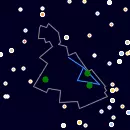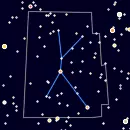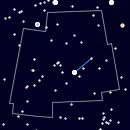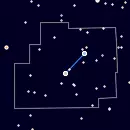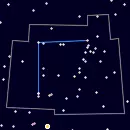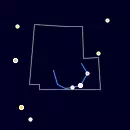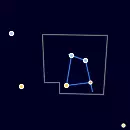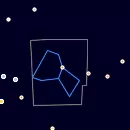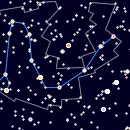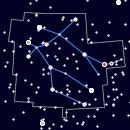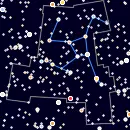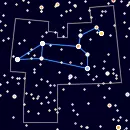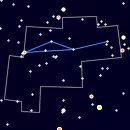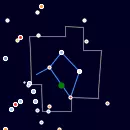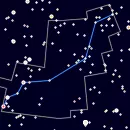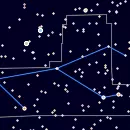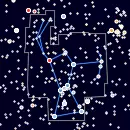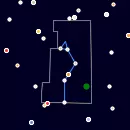Constellations in the Sky Tonight: Find Out What's Visible in the Sky
Sky Map
Celectial bearing and elevation at 00:54
What constellations can you see in the night sky tonight? Discover which star patterns are visible, along with their brightest stars and positions, to enhance your stargazing experience.
Auriga
Constellation
Auriga, the charioteer, is a constellation in the northern sky with the bright star Capella, one of the brightest stars visible from Earth.
Bootes
Constellation
Boötes, the herdsman, is a northern constellation famous for its bright star Arcturus, the fourth brightest star in the night sky.
Camelopardalis
Constellation
Camelopardalis, the giraffe, is a large but faint constellation in the northern sky, representing a giraffe or a camel.
Cancer
Constellation
Cancer, the crab, is a small constellation in the zodiac, known for its dim stars and the open cluster Praesepe, or the Beehive Cluster.
Canes Venatici
Constellation
Canes Venatici, the hunting dogs, is a northern constellation known for its two bright stars, Cor Caroli and Chara, which represent the dogs of the hunter Bootes.
Canis Minor
Constellation
Canis Minor, the lesser dog, is a small constellation in the northern sky, containing the bright star Procyon, part of the Winter Triangle asterism.
Coma Berenices
Constellation
Coma Berenices, Berenice's Hair, is a faint constellation representing the hair of Queen Berenice II of Egypt, famous for its star cluster.
Corona Borealis
Constellation
Corona Borealis, the northern crown, is a small, semicircular constellation in the northern sky, representing the crown of Ariadne.
Corvus
Constellation
Corvus, the crow, is a small constellation representing a crow or raven, located near Virgo and Crater.
Crater
Constellation
Crater, the cup, is a small constellation in the southern sky, representing a cup in Greek mythology, often associated with the god Apollo.
Draco
Constellation
Draco, the dragon, is a northern constellation that winds around the Little Dipper, with its head near Hercules and its tail near Ursa Minor.
Gemini
Constellation
Gemini, the twins, is a zodiac constellation representing the mythological twins Castor and Pollux. It is known for its bright stars, Castor and Pollux, and its prominent place in the winter sky.
Hercules
Constellation
Hercules, named after the Greek hero, is a northern constellation containing the Hercules Cluster, a globular star cluster visible with binoculars.
Leo
Constellation
Leo, the lion, is a zodiac constellation best known for its bright star Regulus and its distinctive backward question mark or sickle shape.
Leo Minor
Constellation
Leo Minor, the smaller lion, is a northern constellation representing a little lion. It contains several faint stars, including Praecipua, and is located between Ursa Major and Leo.
Libra
Constellation
Libra, the scales, is a zodiac constellation symbolizing balance and fairness, located near the constellations Virgo and Scorpius.
Lynx
Constellation
Lynx, the lynx, is a faint northern constellation. Its name refers to the animal known for its sharp sight, symbolizing the challenge of finding its dim stars.
Monoceros
Constellation
Monoceros, the unicorn, is a faint constellation located near Orion, known for containing several star clusters and nebulae.
Orion
Constellation
Orion, the hunter, is a famous constellation with distinctive stars, including Betelgeuse and Rigel, and the Orion Nebula.
Serpens
Constellation
Serpens, the serpent, is a constellation split into two parts, Serpens Caput (the head) and Serpens Cauda (the tail), representing a serpent held by the healer Ophiuchus.
Acknowledgements
We gratefully acknowledge the International Astronomical Union (IAU) for defining and standardizing the official constellation boundaries, which provide a consistent framework for celestial mapping.
Special thanks to Sky & Telescope Magazine and contributors Roger Sinnott and Rick Fienberg for their collaboration in producing the charts and tables. The constellation patterns, drawn by Alan MacRobert, were influenced by the work of H. A. Rey and thoughtfully adjusted to align with earlier traditions.

